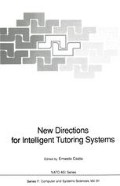Abstract
This chapter argues that an abstract, application-independent, psychologically-neutral level, which we call Computational Mathetics, is needed as a basis for Intelligent Tutoring Systems research. The aims and scope of Computational Mathetics are described by analogy with Computational Linguistics. Some preliminary examples of work within Computational Mathetics are outlined.
Access this chapter
Tax calculation will be finalised at checkout
Purchases are for personal use only
Preview
Unable to display preview. Download preview PDF.
References
Chanier, T., Pengelly, M., Self, J.A. and Twidale, M.B. (1990). Experiments on knowledge acquisition for learner modelling, to be presented at Delta and Beyond Conference, The Hague, Netherlands.
Clancey, WJ. (1986). Qualitative student models, Annual Review of Computer Science, 1, 381–450.
Cohen, P.R. and Levesque, H.J. (1990). Intention is choice with commitment, Artificial Intelligence, 42, 213–261.
Collins, A. and Stevens, A. (1982). Goals and strategies of enquiry teachers, in R. Glaser (ed.), Advances in Instructional Psychology 2, Hillsdale, N J.: New Jersey.
Dillenbourg, P. and Self, J.A. (1990). A framework for learner modelling, Technical Report AI-49, Department of Computing, Lancaster University.
Gazdar, G. and Mellish, C. (1989). Natural Language Processing in Lisp: an Introduction to Computational Linguistics, Reading, Mass.: Addison-Wesley.
Gilmore, DJ. and Self, J.A. (1988). The application of machine learning to intelligent tutoring systems, in J. A. Self (ed.), Artificial Intelligence and Human Learning, London: Chapman and Hall.
Hays, D.G. (1967). Introduction to Computational Linguistics, New York: Elsevier.
Huang, X., McCalla, G., Greer, J. and Neuhold, E. (1991). Revising deductive knowledge and stereotypical knowledge in a student model, in User Modeling and User-Adapted Interaction, 1: 87–115,1991.
Kass, R. (1990). Building a user model implicitly from a cooperative advisory dialog, Proceedings of the Second International Workshop on User Modelling, Hawaii.
Nichols, D. (1990). A viewpoint-based approach to student and domain modelling in intelligent tutoring systems, internal report, Department of Computing, Lancaster University.
Reiter, R. (1987). A theory of diagnosis from first principles, Artificial Intelligence, 32, 57-96.
Self, J.A. (1985). A perspective on intelligent computer-assisted learning, Journal of Computer-Assisted Learning, 1,159–166.
Self, J.A. (1988a). Bypassing the intractable problem of student modelling, Proceedings of Intelligent Tutoring Systems Conference, Montreal, pp. 18–24, C. Frasson (ed.), Univ. Montreal.
Self, J.A. (1988b). Student models — what use are they?, in P. Ercoli and R. Lewis (eds.), Artificial Intelligence Tools in Education, Amsterdam: North-Holand.
Self, J.A. (1990a). Theoretical foundations for intelligent tutoring systems, Journal of Artificial Intelligence in Education, 1, 4, 3–14.
Self, J.A. (1990b). Computational viewpoints, Technical Report AI-44, Department of Computing, Lancaster University.
Self, J.A. (1992). Unravelling the learner model mystery, in F. L. Engel, D.G. Bouwhuis, T. Bösser, G. d’Ydewalle (Eds.), Cognitive Modelling and Interactive Environments in Language Learning. NATO ASI Series F, vol. 87., Berlin: Springer-Verlag.
Sleeman, D.H., Kelly, A.E., Martinak, R., Ward, R.D. and Moore, J.L. (1989). Studies of diagnosis and remediation with high school algebra students, Cognitive Science, 13, 551–568.
Wenger, E. (1987). Artificial Intelligence and Tutoring Systems: Computational and Cognitive Approaches to the Communication of Knowledge, Los Altos: Morgan Kaufmann.
Young, R.M. and O’Shea, T. (1981). Errors in children’s subtraction, Cognitive Science, 5,153–177.
Author information
Authors and Affiliations
Editor information
Editors and Affiliations
Rights and permissions
Copyright information
© 1992 Springer-Verlag Berlin Heidelberg
About this paper
Cite this paper
Self, J. (1992). Computational Mathetics: The Missing Link in Intelligent Tutoring Systems Research?. In: Costa, E. (eds) New Directions for Intelligent Tutoring Systems. NATO ASI Series, vol 91. Springer, Berlin, Heidelberg. https://doi.org/10.1007/978-3-642-77681-6_4
Download citation
DOI: https://doi.org/10.1007/978-3-642-77681-6_4
Publisher Name: Springer, Berlin, Heidelberg
Print ISBN: 978-3-642-77683-0
Online ISBN: 978-3-642-77681-6
eBook Packages: Springer Book Archive

